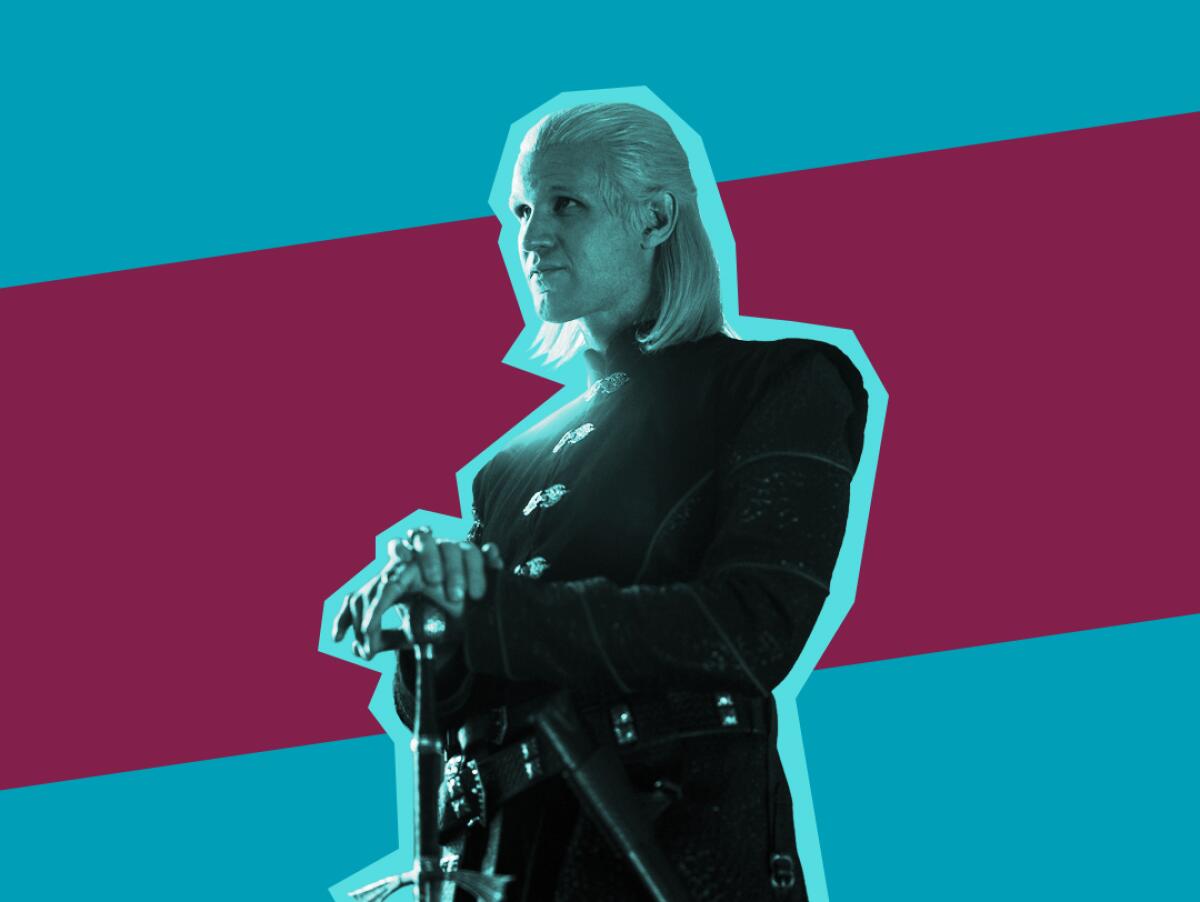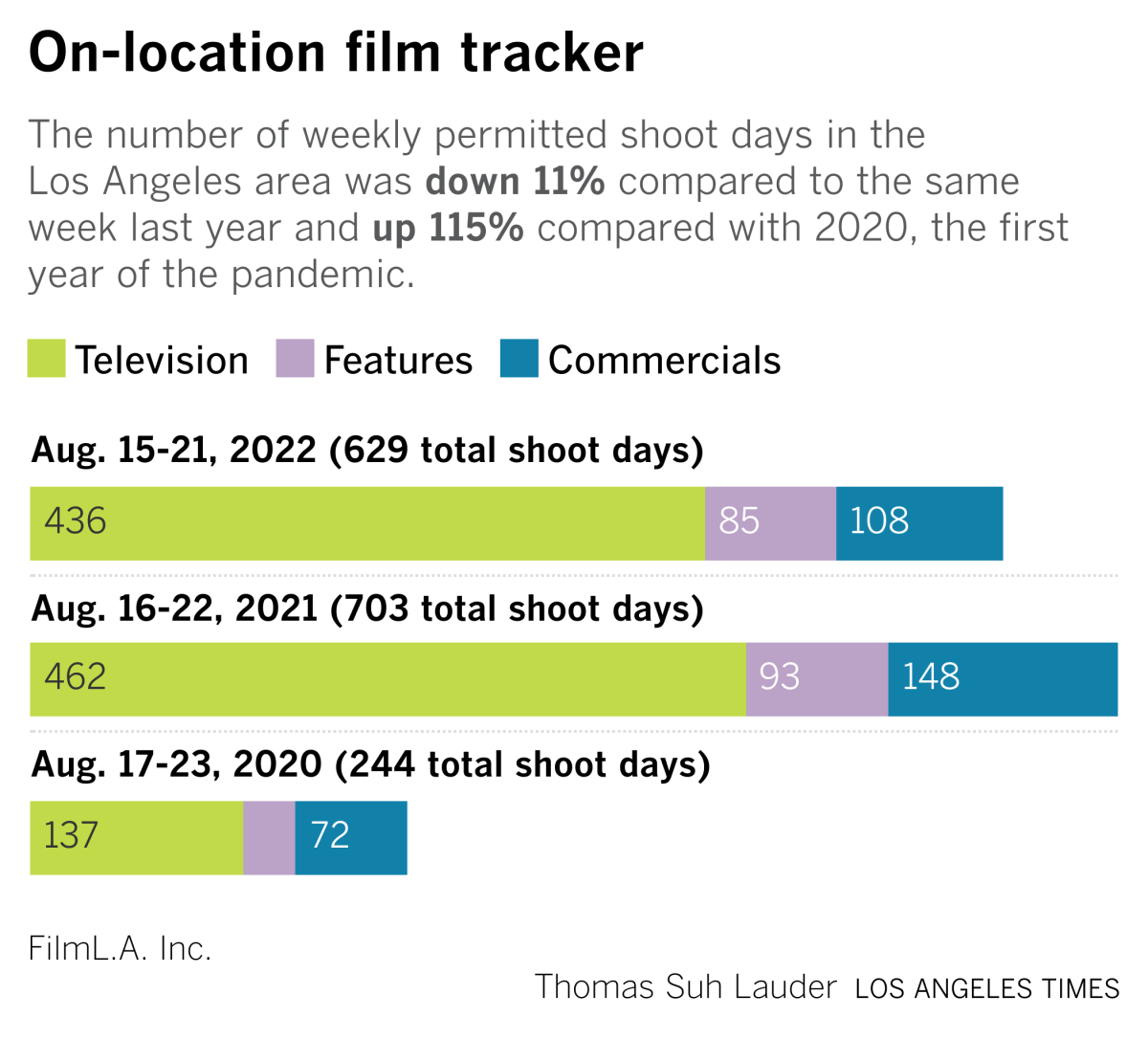Will HBO’s ‘Dragon’ become a market slayer for Warner Bros. Discovery?

Welcome to the Wide Shot, a newsletter about the business of entertainment. Sign up here to get it in your inbox.
Film business reporter and Wide Shot founder Ryan Faughnder is imminently going on paternity leave, so veteran media reporter Meg James is at the controls this week.
Beware of things that breathe fire. HBO on Sunday night launched “House of the Dragon,” the long-awaited prequel to its medieval fantasy extravaganza “Game of Thrones.” That series, known in media circles as “GoT,” was a showpiece of HBO’s audaciousness during the Time Warner Inc. era. Production and marketing budgets were epic! HBO’s parties were over the top!
But the original series delivered on the hype, presenting fictional Westeros, with its fire-breathing dragons, as a feast for the eyes along with heart-pounding story-lines that brought in more fans as the show went deeper into its eight-season run — a rarity in television.
“Game of Thrones” debuted in 2011 — two years before the streaming revolution began. It was a juggernaut long before Time Warner was sold to AT&T, which shrank the company and shifted its priorities to streaming with the debut of HBO Max. Then came Discovery, which with chief executive David Zaslav gobbled up WarnerMedia last spring.
No spoilers here for “House of the Dragon,” except to say the Iron Throne is bigger and more menacing-looking than in “GoT.”
This defies the physics of legacy media, in which things tend to get smaller.
Like HBO itself. Last week, HBO and HBO Max laid off about 70 people, or 14% of its staff, another wave in the painful contraction underway at Warner Bros. Discovery as it struggles to convince Wall Street that the smaller Discovery’s takeover of the company, which added to the mountain of debt, will pay dividends long term.
Warner Bros. Discovery’s stock is down 50% since the deal closed in April, which no doubt gives Zaslav heartburn. (Warner Bros. Discovery shares closed Monday at $12.71, down 7.4%, as the overall stock market plunged).
So a big hit couldn’t come at a better time for the CEO and his empire, and “House of the Dragon” might be just that. The premiere of “House of the Dragon” drew nearly 10 million viewers across linear and HBO Max platforms in the U.S. Sunday night, the largest audience for any new original series in the history of HBO.
On Friday, Zaslav took the unusual step of seemingly declaring the show a hit before it even launched. In an email to staff, Zaslav thanked HBO and HBO Max content chief Casey Bloys and other top HBO executives who “have shepherded what looks to be the next big cultural moment.”
Wall Street, are you listening?
“I had a chance to watch the premiere in Los Angeles with Casey and the team and was blown away by the quality of the production, richness of the story, and power of the action,” Zaslav wrote in the email that touted the marketing campaign, which he called the “largest marketing campaign in HBO’s history — we reached nearly 130 million people in the U.S. alone.”
“House of the Dragon” delivered. It launched with a roar and a gripping plot, apparently causing HBO Max to crash during the premiere.
But Zaslav’s email didn’t mention recent layoffs or controversies, including Warner Bros.’ cancelation of the nearly completed $90-million HBO Max movie “Batgirl” — a move that troubled some filmmakers. The film featured a Latina in the leading role. Zaslav’s note didn’t mention other downsizing, including how the company sold the bulk of its stake in the youth oriented CW network earlier in the week.
Instead, Zaslav underscored his structural strategy: “We are committed to building one team with one mission.”
That mission is complicated by the fatigue of a battle-weary workforce, who have lived through two years of the pandemic and five years of corporate upheaval. Some worry that their heads may also roll — much like the poor souls who faced Prince Daemon Targaryen (Matt Smith) in “House of the Dragon.”
The company faces increased competition from deep-pocketed rivals. In less than two weeks, Amazon Prime Video launches its Lord of the Rings epic , “The Rings of Power.” Ads for that series have swarmed Twitter. In collaboration with movie chain Cinemark, Amazon is making the first two episodes available to fans in theaters Aug. 31 — two days before the series debuts.
Zaslav’s email hinted at an upcoming forced marriage (although not specifically one in the HBO show). The company is working to combine its two streaming services, HBO Max and Discovery+, merging together such shows as “90 Day Fiancé,” “Diners, Drive-Ins, and Dives,” and “Renovation Island” on the same service as“Euphoria,” “Succession” and “House of the Dragon.”
At the very least, there could be some interesting cross-promotions with George R.R. Martin-esque takes on Discovery shows, including “Chopped,” “Cutthroat Kitchen,” “Naked and Afraid” and “Dude, You’re Screwed.”
Trojans, Bruins help tip the scales

Last week, venerable broadcasters CBS, Fox and NBC teamed up to grab TV rights to Big Ten conference college football games, announcing a record-shattering $1.2-billion-a-year pact that would have been unthinkable just a few years ago.
Boosted by the planned switch of UCLA and USC from the Pac-12 to the Big Ten conference in 2024, the Midwestern powerhouse league soon will be a a coast-to-coast draw. The broadcasters agreed to pay more than double the existing price tag for the games, a reported $430 million a year. The networks plan to divvy up the contests so each has a powerful Saturday draw.
As CBS’ sports chief Sean McManus told The Times’ Sam Farmer: “The conference is more valuable with USC and UCLA in it.”
But there’s a lot more here beyond the addition of the L.A. colleges. Broadcasters desperately need sports to please viewers and advertisers, and audiences for cable outlets, including the powerhouse ESPN, have been on the decline. The deal comes during troubled times for media companies. ESPN gave up valuable rights to the conference, instead focusing on the Southeastern Conference.
Programming costs are rising but executives know that sports will continue to deliver. There’s also the less prominent but just as important lure. Legacy companies like NBCUniversal, Fox and CBS parent Paramount Global rely on the huge checks they receive from the cable and satellite TV companies, which pay the networks for the rights to distribute TV station signals. These so-called retransmission fees have helped broadcasters maintain their financial footing. Also, these broadcasters didn’t want to fumble the ball to interloper tech companies like Amazon or Apple.
Stuff we wrote
— Safety troubles for concert promoter Live Nation. The stabbing death of South L.A. rapper Drakeo the Ruler was just the latest in a series of high-profile acts of violence that have shadowed the concert business, and the world’s largest promotion company, for years. Music writer August Brown reports, in a subscriber exclusive, that after the deadly Astroworld catastrophe in Texas and Drakeo’s stabbing in Los Angeles, Live Nation faces mounting questions over concert safety. Drakeo’s brother told Brown that their crew felt uneasy with the lax security. They didn’t see any security cameras or law enforcement backstage.
— Palisades Media’s family plan. Wendy Lee broke another exclusive on the troubles at Palisades Media Group, the Santa Monica agency that placed ads for Netflix, among others, before abruptly closing this summer. For nearly two decades, the two stepsons of CEO Roger Schaffner were employed there. The problem: Managers said they did not actually perform their duties and rarely showed up for work.
— Brian Stelter is out at CNN. New CNN chief Chris Licht‘s first major move was to cancel one of CNN’s longest-running programs, “Reliable Sources,” and toss out the anchor, Brian Stelter, who was most closely associated with his predecessor, Jeff Zucker, Stephen Battaglio wrote. Stelter bid adieu Sunday, the final episode of the show.
— Talk about a drought. A box office lull has put major financial pressure on some of the biggest cinema chains, Ryan Faughnder wrote. Several factors, including COVID-19-driven production delays, a bottleneck at visual effects firms and the steering of more films to streaming services instead of theaters is putting financial pressure on longtime industry partners.
— Britain boom. Production is once again enjoying a surge in activity in the U.K., with record levels of filming. Anousha Sakoui reports from London about the boom — and the burnout.
— From El Monte to the executive suite. Cris Abrego is one of few Latino executives in the top executive ranks of Hollywood as chairman of the Americas for Banijay, the reality TV juggernaut. I traced Abrego’s journey from his high school east of Los Angeles, and the story actually begins before Cris was even born — during the Chicano movement of the late 1960s. The story also is available in Spanish.
Number of the week

Nielsen reported that, for the first time, viewership of streaming services topped that of cable TV channels in July.
Ryan Faughnder wrote about this symbolic milestone in the industry. Traditional television, however, still generates the most viewing if you combine the percentages for broadcast networks and cable channels (more than 55% of viewing), which Nielsen reports as separate categories. Streaming notched a record 34.8% of total TV consumption last month, while cable accounted for 34.4%. Broadcast television grabbed 21.6%.
Catch-up reading...

— The Times’ Meredith Blake looks at how “The House of the Dragon” premiere episode feels particularly relevant in the post-Roe vs. Wade world.
— Wall Street Journal’s Joe Flint looks at the age-old debate: Should Disney get rid of ESPN, in light of an activist investor’s calls to pare assets?
— James Hibberd explores the fight for eyeballs among the fantasy juggernauts. Which will be a bigger hit: HBO’s “House of the Dragon” or Amazon Prime Video’s “Lord of the Rings” franchise?
Hollywood production
Shoot days in the Los Angeles area were down 11% last week, compared with the same period of time in 2021.

Finally ... Ode to the WB, UPN and CW
It’s too soon to know how dramatically the CW will change under Nexstar’s tenure. As my colleague Steve Battaglio wrote, Nexstar is expected to slowly shift the focus from shows that appeal to young viewers to ones that might be more compatible to an older-skewing audience. Nexstar relies on its local newscasts, like those produced by its L.A. station, KTLA-TV Channel 5, for revenue.
The CW wasn’t profitable, which is part of the reason it was being sold. Its value to the owners was as a “studio play,” allowing the Warner Bros. and CBS television studios to employ more writers, actors and create shows that would live on beyond their network life (including on Netflix).
Let’s not forget the big accomplishments of two generations of youth-oriented networks. CW was the amalgamation, in 2006, of two competitors WB, owned by Warner Bros; and UPN, initially owned by Viacom, then CBS. The smaller networks punched above their weight class, delivering shows that struck the cultural zeitgeist and launched the career of many stars and show runners.
WB spawned “Dawson’s Creek,” “7th Heaven,” “Buffy the Vampire Slayer,” (which moved to UPN), “Gilmore Girls,” “Smallville,” and “Everwood.” UPN was daring in its day: “America’s Next Top Model,” “Girlfriends,” “Everybody Hates Chris” and “Veronica Mars.” And of course the CW showed its moxie with “Gossip Girl,” “The Vampire Diaries,” “Jane the Virgin” and “Riverdale,” which is about to launch its seventh and final season.
One more click! Please follow me on Twitter: @MegJamesLAT
Inside the business of entertainment
The Wide Shot brings you news, analysis and insights on everything from streaming wars to production — and what it all means for the future.
You may occasionally receive promotional content from the Los Angeles Times.




